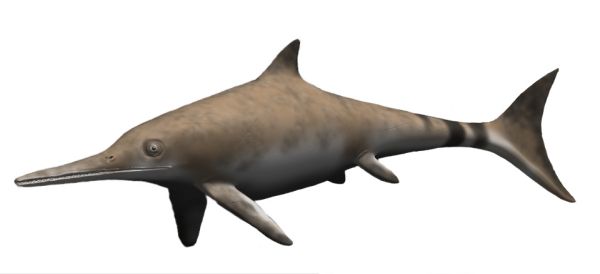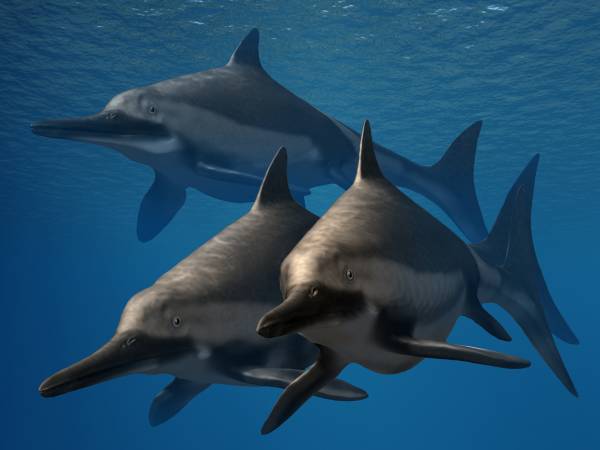|
Thunnosauria
Thunnosauria (Greek for "tuna lizard" – ''thunnos'' meaning "tuna" and ''sauros'' meaning "lizard") is an extinct clade of parvipelvian ichthyosaurs from the Early Jurassic to the early Late Cretaceous ( Hettangian– Cenomanian) of Asia, Australia, Europe, North America, and South America. Named by Ryosuke Motani in 1999, it contains the basal taxa ''Ichthyosaurus'' and '' Stenopterygius'' and the family Ophthalmosauridae. In thunnosaurs, the fore fin is at least twice as long as the hind fin. Phylogeny Thunnosauria is a node-based taxon defined in 1999 as "the last common ancestor of '' Ichthyosaurus communis'' and ''Stenopterygius quadriscissus'' and all of its descendants". The cladogram A cladogram (from Greek ''clados'' "branch" and ''gramma'' "character") is a diagram used in cladistics to show relations among organisms. A cladogram is not, however, an evolutionary tree because it does not show how ancestors are related to ... below follows the topology fr ... [...More Info...] [...Related Items...] OR: [Wikipedia] [Google] [Baidu] |
Chacaicosaurus
''Chacaicosaurus'' is a genus of neoichthyosaurian ichthyosaur known from the Middle Jurassic of Argentina. The single known specimen of this genus was excavated from the Los Molles Formation in Neuquén Province, and is housed at the Museo Olsacher under the specimen number MOZ 5803. This specimen consists of a skull, forelimb, some vertebrae, and some additional postcranial elements. The genus was named by Marta Fernández in 1994, and contains a single species, ''Chacaicosaurus cayi'', making it the first named distinctive ichthyosaur from the Bajocian stage. It is a medium-sized ichthyosaur with a very long snout, which bears a ridge running along each side. The forelimbs of ''Chacaicosaurus'' are small and contain four main digits. Different authors have classified ''Chacaicosaurus'' in different ways; some consider it a thunnosaur closely related to the ophthalmosaurids, others instead place it outside of Thunnosauria, often near '' Hauffiopteryx''. However, as it is ... [...More Info...] [...Related Items...] OR: [Wikipedia] [Google] [Baidu] |
Ichthyosaur
Ichthyosaurs (Ancient Greek for "fish lizard" – and ) are large extinct marine reptiles. Ichthyosaurs belong to the order known as Ichthyosauria or Ichthyopterygia ('fish flippers' – a designation introduced by Sir Richard Owen in 1842, although the term is now used more for the parent clade of the Ichthyosauria). Ichthyosaurs thrived during much of the Mesozoic era; based on fossil evidence, they first appeared around 250 million years ago ( Ma) and at least one species survived until about 90 million years ago, into the Late Cretaceous. During the Early Triassic epoch, ichthyosaurs and other ichthyosauromorphs evolved from a group of unidentified land reptiles that returned to the sea, in a development similar to how the mammalian land-dwelling ancestors of modern-day dolphins and whales returned to the sea millions of years later, which they gradually came to resemble in a case of convergent evolution. Ichthyosaurs were particularly abundant in the Late Triassic a ... [...More Info...] [...Related Items...] OR: [Wikipedia] [Google] [Baidu] |
Parvipelvia
Parvipelvia (Latin for "little pelvis" - ''parvus'' meaning "little" and ''pelvis'' meaning "pelvis") is an extinct clade of euichthyosaur ichthyosaurs that existed from the Late Triassic to the early Late Cretaceous (middle Norian to Cenomanian) of Asia, Australia, Europe, North America and South America. Named by Ryosuke Motani, in 1999, it contains the basal taxa like '' Macgowania'' and '' Hudsonelpidia''. Maisch and Matzke (2000) found in their analysis seven synapomorphies that support Parvipelvia. They also found 10 synapomorphies that support the existence of post-Triassic clade of ichthyosaurs (all parvipelvians excluding ''Macgowania'' and ''Hudsonelpidia''), for which the name Neoichthyosauria was found to be available. Parvipelvians were the only ichthyosaurs to survive the Triassic-Jurassic extinction event. Phylogeny Parvipelvia is a node-based taxon defined in 1999 as "the last common ancestor of ''Hudsonelpidia'', ''Macgowania'', ''Ichthyosaurus'' and al ... [...More Info...] [...Related Items...] OR: [Wikipedia] [Google] [Baidu] |
Ophthalmosauridae
Ophthalmosauridae is an extinct family of thunnosaur ichthyosaurs from the Middle Jurassic to the early Late Cretaceous (Bajocian - Cenomanian) worldwide. Almost all ichthyosaurs from the Middle Jurassic onwards belong to the family, until the extinction of ichthyosaurs in the early Late Cretaceous. Opthalmosaurids appeared worldwide during early Bajocian, subsequent to the disappearance of most other ichthyosaur lineages after the end of the Toarcian. Currently, the oldest known ophthalmosaurids is ''Mollesaurus'' from the early Bajocian of Argentina, as well as indeterminate remains of the same age from Luxembourg and Canada. Named by George H. Baur, in 1887, the family contains the basal taxa like ''Ophthalmosaurus''. Appleby (1956) named the taxon Ophthalmosauria which was followed by some authors, but these two names are often treated as synonyms; Ophthalmosauridae has the priority over Ophthalmosauria. However, some researchers argue that Ophthalmosauridae should be restricte ... [...More Info...] [...Related Items...] OR: [Wikipedia] [Google] [Baidu] |
Stenopterygius
''Stenopterygius'' is an extinct genus of thunnosaur ichthyosaur known from Europe (England, France, Germany, Luxembourg and Switzerland). This genus of ichthyosaur was about long and weighed .Huene F. von 1939. Ein ganzes Ichthyosaurier-Skelett aus den westschweizerischen Voralpen. ''Mitteilungen der Naturforschenden Gesellschaft in Bern'' 1939, pp.: 1-14McGowan C, Motani R. 2003. Ichthyopterygia. – In: Sues, H.-D. (ed.): ''Handbook of Paleoherpetology, Part 8, Verlag Dr. Friedrich Pfeil'', 175 pp., 101 figs., 19 plts; München History ''Stenopterygius'' was originally named by Quenstedt in 1856 as a species of ''Ichthyosaurus'', ''I. quadriscissus''. Otto Jaekel in 1904 reassigned it to its own genus, ''Stenopterygius''. The type species is therefore ''Stenopterygius quadriscissus''. The generic name is derived from ''stenos'', Greek for "narrow", and ''pteryx'' (πτερυξ), Greek for "fin" or "wing". Description ''Stenopterygius'' was physically similar to the better k ... [...More Info...] [...Related Items...] OR: [Wikipedia] [Google] [Baidu] |
Stenopterygius Quadriscissus
''Stenopterygius'' is an extinct genus of thunnosaur ichthyosaur known from Europe (England, France, Germany, Luxembourg and Switzerland). This genus of ichthyosaur was about long and weighed .Huene F. von 1939. Ein ganzes Ichthyosaurier-Skelett aus den westschweizerischen Voralpen. ''Mitteilungen der Naturforschenden Gesellschaft in Bern'' 1939, pp.: 1-14McGowan C, Motani R. 2003. Ichthyopterygia. – In: Sues, H.-D. (ed.): ''Handbook of Paleoherpetology, Part 8, Verlag Dr. Friedrich Pfeil'', 175 pp., 101 figs., 19 plts; München History ''Stenopterygius'' was originally named by Quenstedt in 1856 as a species of '' Ichthyosaurus'', ''I. quadriscissus''. Otto Jaekel in 1904 reassigned it to its own genus, ''Stenopterygius''. The type species is therefore ''Stenopterygius quadriscissus''. The generic name is derived from ''stenos'', Greek for "narrow", and ''pteryx'' (πτερυξ), Greek for "fin" or "wing". Description ''Stenopterygius'' was physically similar to the better ... [...More Info...] [...Related Items...] OR: [Wikipedia] [Google] [Baidu] |
Stenopterygius BW
''Stenopterygius'' is an extinct genus of thunnosaur ichthyosaur known from Europe (England, France, Germany, Luxembourg and Switzerland). This genus of ichthyosaur was about long and weighed .Huene F. von 1939. Ein ganzes Ichthyosaurier-Skelett aus den westschweizerischen Voralpen. ''Mitteilungen der Naturforschenden Gesellschaft in Bern'' 1939, pp.: 1-14McGowan C, Motani R. 2003. Ichthyopterygia. – In: Sues, H.-D. (ed.): ''Handbook of Paleoherpetology, Part 8, Verlag Dr. Friedrich Pfeil'', 175 pp., 101 figs., 19 plts; München History ''Stenopterygius'' was originally named by Quenstedt in 1856 as a species of '' Ichthyosaurus'', ''I. quadriscissus''. Otto Jaekel in 1904 reassigned it to its own genus, ''Stenopterygius''. The type species is therefore ''Stenopterygius quadriscissus''. The generic name is derived from ''stenos'', Greek for "narrow", and ''pteryx'' (πτερυξ), Greek for "fin" or "wing". Description ''Stenopterygius'' was physically similar to the better ... [...More Info...] [...Related Items...] OR: [Wikipedia] [Google] [Baidu] |
Ichthyosaurus
''Ichthyosaurus'' (derived from Greek ' () meaning 'fish' and ' () meaning 'lizard') is a genus of ichthyosaurs from the Early Jurassic ( Hettangian - Pliensbachian), with possible Late Triassic record, from Europe (Belgium, England, Germany, Switzerland, and Portugal). It is among the best known ichthyosaur genera, as it is the type genus of the order Ichthyosauria.Maisch MW, Matzke AT. 2000. The Ichthyosauria. ''Stuttgarter Beiträge zur Naturkunde, Serie B (Geologie und Paläontologie)'' 298: 1-159McGowan C, Motani R. 2003. Ichthyopterygia. – In: Sues, H.-D. (ed.): ''Handbook of Paleoherpetology, Part 8, Verlag Dr. Friedrich Pfeil'', 175 pp., 101 figs., 19 plts; MünchenMaisch MW, Reisdorf AG, Schlatter R, Wetzel A. 2008. A large skull of Ichthyosaurus (Reptilia: Ichthyosauria) from the Lower Sinemurian (Lower Jurassic) of Frick (NW Switzerland). ''Swiss Journal of Geosciences'' 101: 617-627. History of discovery ''Ichthyosaurus'' was the first complete fossil to be discov ... [...More Info...] [...Related Items...] OR: [Wikipedia] [Google] [Baidu] |
Ichthyosaurus Communis
''Ichthyosaurus'' (derived from Greek ' () meaning 'fish' and ' () meaning 'lizard') is a genus of ichthyosaurs from the Early Jurassic (Hettangian - Pliensbachian), with possible Late Triassic record, from Europe (Belgium, England, Germany, Switzerland, and Portugal). It is among the best known ichthyosaur genera, as it is the type genus of the order Ichthyosauria.Maisch MW, Matzke AT. 2000. The Ichthyosauria. ''Stuttgarter Beiträge zur Naturkunde, Serie B (Geologie und Paläontologie)'' 298: 1-159McGowan C, Motani R. 2003. Ichthyopterygia. – In: Sues, H.-D. (ed.): ''Handbook of Paleoherpetology, Part 8, Verlag Dr. Friedrich Pfeil'', 175 pp., 101 figs., 19 plts; MünchenMaisch MW, Reisdorf AG, Schlatter R, Wetzel A. 2008. A large skull of Ichthyosaurus (Reptilia: Ichthyosauria) from the Lower Sinemurian (Lower Jurassic) of Frick (NW Switzerland). ''Swiss Journal of Geosciences'' 101: 617-627. History of discovery ''Ichthyosaurus'' was the first complete fossil to be discovere ... [...More Info...] [...Related Items...] OR: [Wikipedia] [Google] [Baidu] |
Ichthyosaurus BW
''Ichthyosaurus'' (derived from Greek ' () meaning 'fish' and ' () meaning 'lizard') is a genus of ichthyosaurs from the Early Jurassic (Hettangian - Pliensbachian), with possible Late Triassic record, from Europe (Belgium, England, Germany, Switzerland, and Portugal). It is among the best known ichthyosaur genera, as it is the type genus of the order Ichthyosauria.Maisch MW, Matzke AT. 2000. The Ichthyosauria. ''Stuttgarter Beiträge zur Naturkunde, Serie B (Geologie und Paläontologie)'' 298: 1-159McGowan C, Motani R. 2003. Ichthyopterygia. – In: Sues, H.-D. (ed.): ''Handbook of Paleoherpetology, Part 8, Verlag Dr. Friedrich Pfeil'', 175 pp., 101 figs., 19 plts; MünchenMaisch MW, Reisdorf AG, Schlatter R, Wetzel A. 2008. A large skull of Ichthyosaurus (Reptilia: Ichthyosauria) from the Lower Sinemurian (Lower Jurassic) of Frick (NW Switzerland). ''Swiss Journal of Geosciences'' 101: 617-627. History of discovery ''Ichthyosaurus'' was the first complete fossil to be disc ... [...More Info...] [...Related Items...] OR: [Wikipedia] [Google] [Baidu] |
Ophthalmosaurus
''Ophthalmosaurus'' (meaning "eye lizard" in Greek) is an ichthyosaur of the Jurassic period (165–150 million years ago). Possible remains from the Cretaceous, around 145 million years ago, are also known. It was a relatively medium-sized ichthyosaur, measuring long and weighing . Named for its extremely large eyes, it had a jaw containing many small but robust teeth. Major fossil finds of this genus have been recorded in Europe with a second species possibly being found in North America. Description ''Ophthalmosaurus'' was a medium-sized ichthyosaur, measuring long and weighing . It had a robust, streamlined body that was nearly as wide as it was tall in frontal view. Like other derived ichthyosaurs ''Ophthalmosaurus'' had a powerful tail ending in a pronounced bi-lobed caudal fluke whose lower half was formed around the caudal spine whereas the upper lobe was made up entirely from soft tissue. The limbs of ''Ophthalmosaurus'' were short and rounded with the forelimbs bein ... [...More Info...] [...Related Items...] OR: [Wikipedia] [Google] [Baidu] |
Ichthyosauridae
Ichthyosauridae is an extinct family of thunnosaur ichthyosaurs from the latest Triassic and Early Jurassic (Rhaetian to Pliensbachian stages) of Europe, and possibly also from the middle Early Cretaceous (Hauterivian or Barremian stage) of Iraq. Named by Charles Lucien Bonaparte, in 1841, it is usually thought to contain a single genus, '' Ichthyosaurus'', which is known from several species from the Early Jurassic. In 2013, Fischer ''et al.'' named and described '' Malawania anachronus'' from the middle Early Cretaceous of Iraq. It was found to share several synapomorphies with the type species of this family, ''Ichthyosaurus communis'', and a large phylogenetic analysis recovered these species as sister taxa. Despite its geologically younger age, ''M. anachronus'' was also assigned to Ichthyosauridae. Phylogeny Fischer ''et al.'' (2013) applied the name Ichthyosauridae Bonaparte, 1841 for the clade that contains '' Malawania anachronus'' and ''Ichthyosaurus communis''. This ... [...More Info...] [...Related Items...] OR: [Wikipedia] [Google] [Baidu] |







_(21069255568)_(cropped).jpg)